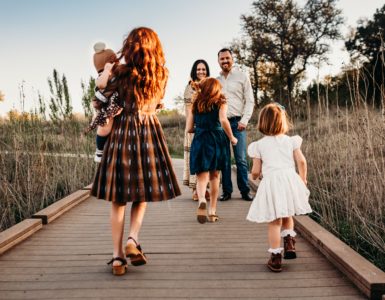As an English major, studying figurative language was something I did almost every day. As a little review, figurative language is language that goes beyond its literal meaning to convey a point. There are quite a few figures of speech that refer to adoption. Not only does it enhance the language surrounding adoption, but it also makes adoption more comprehensible for people who are maybe unfamiliar with it. Here are some of my favorite figures of speech that refer to adoption.
Growing in a Mother’s Heart (Metaphor)
A metaphor is a figure of speech in which a term or phrase is applied to something to which it is not literally applicable in order to suggest a resemblance. Metaphors are effective because they use comparison to liken something possibly unfamiliar to the reader with something the reader may better understand. Furthermore, they can create stronger visuals that may mean more to the reader than a regular description. One famous metaphor comes from the famous Katy Perry song Firework. In the refrain, Perry sings “Baby, you’re a firework. Come on, let your colors burst.” She is not singing to a literal firework, but rather, encouraging the listener to show off their beauty in the same showy, attention-grabbing display that fireworks do.
When I was little, I, like many of my friends the same age, asked my parents where I came from. While most parents were able to tell their children the watered-down version—that they grew in their mom’s tummy—my parents had the added task of telling me I did not grow in my mom’s tummy but in some other woman’s tummy. It was hard for me to understand why my mom could not grow me in her tummy or why my birth mother would not want to raise me.
After a few weeks (and a few google searches), my parents found the phrase “Adoption is when a child grows in a Mommy’s heart instead of her tummy.” This metaphor solidifies the idea that adoptees and their parents are family—that they have some physical connection that is akin to pregnancy. Unfortunately, there are some insensitive people in the world that think adoption is nothing more than a legal connection, but this metaphor helps illustrate that is simply not true. This metaphor emphasizes that an adopted family is just as valid as a biological one because it highlights the emotional and physical connection between adopted children and their parents. It does not make adopted children seem inferior for lacking that physical connection, but rather, emphasizes a different kind of non-literal physical connection.
This metaphor is especially helpful for little children because it helps them to connect to something familiar like the idea that children grow in their mothers’ tummies, with something harder to understand, like the idea that adoptees did not grow in their mother’s tummies and have a family they are not biologically related to. Furthermore, it emphasizes that adoptive parents love and want their children just as much as biological parents: a sentiment that goes a long way when a kid is trying to process why their birth parent(s) would place them. Depicting an adoptee as growing in their parent’s heart highlights the strong connection that non-biological families have despite being unrelated by blood.
The Invisible Red Thread (Symbolism)
Symbolism is the use of symbols to convey ideas or qualities. Symbolism is effective because it gives a concrete visual to an otherwise abstract idea. A good example of symbolism seen in movies, books, and poems is the use of rain to symbolize rebirth. This symbol likely derives from the biblical story of Noah; however, even in secular books, movies, and poems, the rain represents the washing away of something. A lot of films have that one scene where two characters confess their love for each other in the rain—the rain symbolizes the beginning of a new relationship and the washing away of whatever prejudices the characters had towards each other. Symbols are everywhere, and the beautiful thing about them is that they are universally understood by people (however, some symbols do vary from culture to culture).
There is a Chinese proverb that involves an invisible red thread (also known as the Red Thread of Fate or the Red String of Fate). The ancient Chinese myth held that the god of love tied a red thread around the index fingers of people who are destined to meet, regardless of time, place, or circumstance. The thread may stretch or tangle, but it will never break. In Chinese culture, this symbol of the invisible thread is often applied to adoptees and their parents.
Like the metaphor above, this symbol is so beautiful because it emphasizes a physical connection between non-biological families. It illustrates one idea that adoption has a deeper connection. I love the fact that even though the string is invisible, it is also red. When I first heard this proverb, I was curious as to why they would even assign the string a color because it was invisible, it did not seem like color mattered. However, it made more sense when I considered that the color red in Chinese culture is a popular color that itself symbolizes happiness and good fortune. Thus, the color red in this proverb goes to show that the invisible string is a positive thing as it links together people who are meant to be strong positive influences in each other’s lives.
The symbol of a thread is also important here. Threads and strings are notoriously thin. The idea that a string that can bend or tangle but not break attaches two people who are meant to be connected is beautiful in that it is not forceful. Imagine if the image was a rope or chain of fate- that image would be more aggressive and come with negative associations like captivity and prison. The image of a thread or a string is far gentler, and it fosters the idea of a prevailing connection (as the thread cannot break).
This image of an invisible red thread connecting an adoptee with his or her parents is one that I love, especially because it derives from the culture I am biologically connected with. The symbol of an invisible thread gives a concrete image to an otherwise abstract concept—that non-biological families have a special connection. This symbol stands for the fact that out of seven billion people on this planet, adoptees have a unique connection to their adoptive families. It goes to show that even though the confusion of being placed for adoption by biological parents and adopted by non-biological parents, non-biological families have a special, unbreakable connection.
The Blood of The Covenant is Thicker Than The Water of The Womb (Aphorism)
An aphorism is a concise, short observation that contains a general truth. Aphorisms are effective literary devices as they use specific language to leave a memorable imprint on the reader. A famous aphorism used frequently is the saying “Absence makes the heart grow fonder.” This statement is succinct, but it is also more memorable than saying “Absence makes you miss someone/something more.”
Almost everyone has heard of the saying: “Blood is thicker than water.” People use this aphorism to express that family is everything. However, this saying implies that biological connections prevail over adopted families as well as every other chosen family. This saying used to bother me a lot, as it does many other adoptees. Think about it: telling an adopted child that biological relationships trump non-biological ones is like a slap to the face. My friends who all had biological parents were supposed to prioritize them, but who was I supposed to prioritize? And who was supposed to prioritize me? The idea that it takes blood to create a family is not one that I care to entertain because it is hurtful to people who do not have biological families.
I recently found out that the saying “blood is thicker than water” is actually not the true aphorism. The full saying is: “The blood of the covenant is thicker than the water of the womb.” Roughly translated, this means we should prioritize the people who are always there for us over the people we are biologically related to. If the people who are always there for us are also the people we are biologically related to, then great! If not, then this saying still signals that all non-biological families are just as important as biological families. My friends’ biological parents went to their soccer games, cooked them dinner, and stayed with them if they were sick. My non-biological parents did these same things for me growing up, so why would I regard my parents any less than my friends regard their parents? “The blood of the covenant is thicker than the water of the womb” conveys exactly that—my non-biological family is just as significant as any biological family.
It Takes a Village (Hyperbole)
A hyperbole is an exaggerated statement that is not meant to be taken literally. Hyperboles are effective because they create strong visuals and leave memorable impressions in readers’ minds. One example of hyperbole in everyday life is when people say, “I am so hungry I could eat a horse.” The speaker probably couldn’t eat an entire horse in one sitting. Yet, saying you could eat a horse is more effective at explaining how hungry you are than “I am very hungry” because one can gauge the size of a horse.
When I was a baby, I allegedly got lost in a small coastal town in Ireland while my parents were there visiting family. My parents freaked out and started frantically searching for me, hoping that I had not toddled out to the ocean by myself. Soon, my parents’ friends joined in the search. They went to their neighbors and asked if they had seen me. As news spread that a little Asian girl was lost by the ocean, crowds of people joined in the search. After an hour of searching and with a team of about 50 people assembled, someone finally found me sleeping under the bed at my parents’ friend’s house. This is a rather literal example of it taking a village to achieve a goal, but this was a dire situation, and all the neighbors were friends so probably not a typical occurrence.
“It takes a village” is a common hyperbole used to refer to both adoptees and biological children. The idea of a village coming together to take care of a child has always been a heart-warming image for me. However, it is obviously an exaggeration. It probably does not take an entire village to adequately raise a child. I like this hyperbole because it keeps adoption expectations realistic. A lot of prospective adoptive parents (me included) sometimes picture ourselves raising our kids with no outside interference like Super Mom. But this is just not realistic, and we will need to rely on friends and family for support every once in a while. And sometimes we literally need an entire village to help us with our children. Thus, the idea of an entire village raising a child is an image that more accurately describes adoption as well as being a parent in general.
These figures of speech, along with many others, keep the language referring to adoption digestible. They serve to validate the importance of non-biological families as well as attribute tangible images to the unseen connections which brought and continues to bring non-biological families together (such as the invisible red thread or a baby growing in a mother’s tummy or heart). Figurative language is not only fun, but it takes words and paints pictures in a way that regular language cannot. This figurative language is a nice way of diverging from the blandness of everyday speech to create images depicting just how beautiful adoption is.




